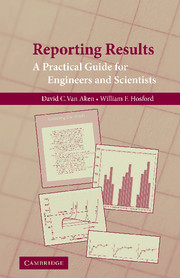Book contents
- Frontmatter
- Contents
- Preface
- REPORTING RESULTS
- 1 Elements of Technical Writing
- 2 Technical Papers
- 3 Technical Letters
- 4 Oral Presentations
- 5 Presentation of Technical Data
- 6 Statistical Analysis of Experimental Data
- 7 Resumé Writing
- Appendix I COMMON ERRORS IN WRITING
- Appendix II PUNCTUATION
- Appendix III COMMON WORD ERRORS
- Appendix IV INTERNATIONAL SYSTEM OF PREFIXES AND UNITS
- Appendix V THE GREEK ALPHABET AND TYPICAL USES
- Appendix VI STRAIGHT-LINE PLOTS FOR SOME MATHEMATICAL FUNCTIONS
- References
- Index
Appendix II - PUNCTUATION
Published online by Cambridge University Press: 05 September 2012
- Frontmatter
- Contents
- Preface
- REPORTING RESULTS
- 1 Elements of Technical Writing
- 2 Technical Papers
- 3 Technical Letters
- 4 Oral Presentations
- 5 Presentation of Technical Data
- 6 Statistical Analysis of Experimental Data
- 7 Resumé Writing
- Appendix I COMMON ERRORS IN WRITING
- Appendix II PUNCTUATION
- Appendix III COMMON WORD ERRORS
- Appendix IV INTERNATIONAL SYSTEM OF PREFIXES AND UNITS
- Appendix V THE GREEK ALPHABET AND TYPICAL USES
- Appendix VI STRAIGHT-LINE PLOTS FOR SOME MATHEMATICAL FUNCTIONS
- References
- Index
Summary
There is an excellent (and humorous) book, Eats, Shoots and Leaves by Lynn Truss (2003) that gives British rules for punctuation. The title emphasizes the importance of punctuation. The meaning of the title would be completely changed if the comma after Eats were omitted. Some excellent resources for American punctuation rules are Webster's Standard American Style Manual (1985) and The ACS Style Guide: A Manual for Authors and Editors (Dodd 1986). The following is a brief summary of punctuation that should serve as a starting point.
Commas
Commas have several uses. One is to substitute for and or or in a list of nouns. For example, The experiment required a volt meter, some wire, an oscilloscope, and a battery or The alloy usually contains aluminum, titanium, or niobium. Commas are also used with lists of adjectives. For example, The flag was red, white, and blue. The comma before the final and or or is called the serial comma. Americans tend to use the serial comma, whereas the British do not. The writer should pick one usage and be consistent.
Commas are also used to join separate clauses. The volt meter was read after one minute, and the reading was recorded.
Pairs of commas are used around a parenthetical comment such as The engineer, a graduate of Cal Tech, was very clever or The author, L. H. Van Vlack, wrote many other texts.
- Type
- Chapter
- Information
- Reporting ResultsA Practical Guide for Engineers and Scientists, pp. 123 - 132Publisher: Cambridge University PressPrint publication year: 2008



